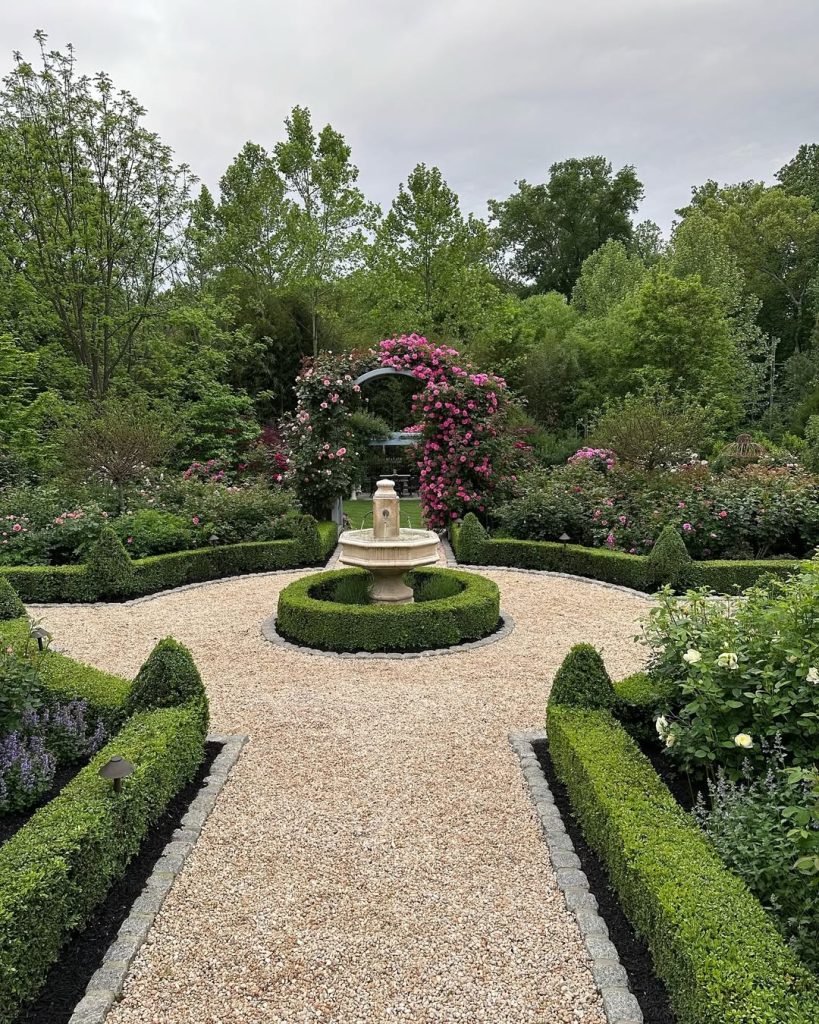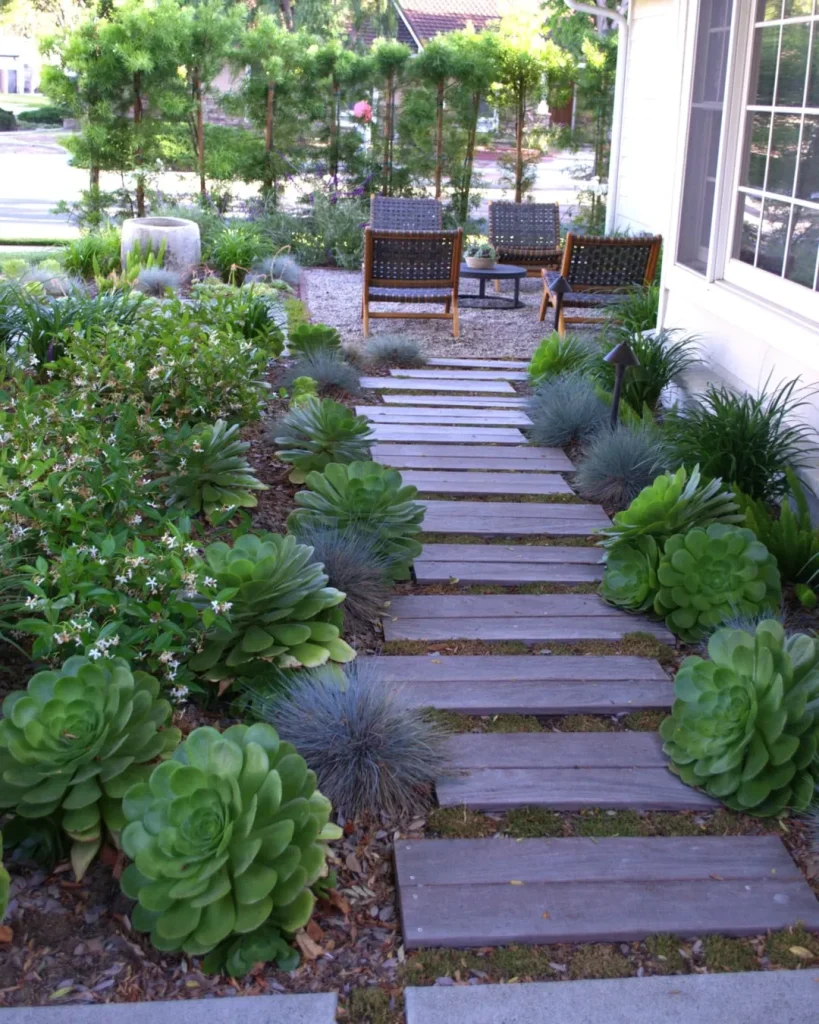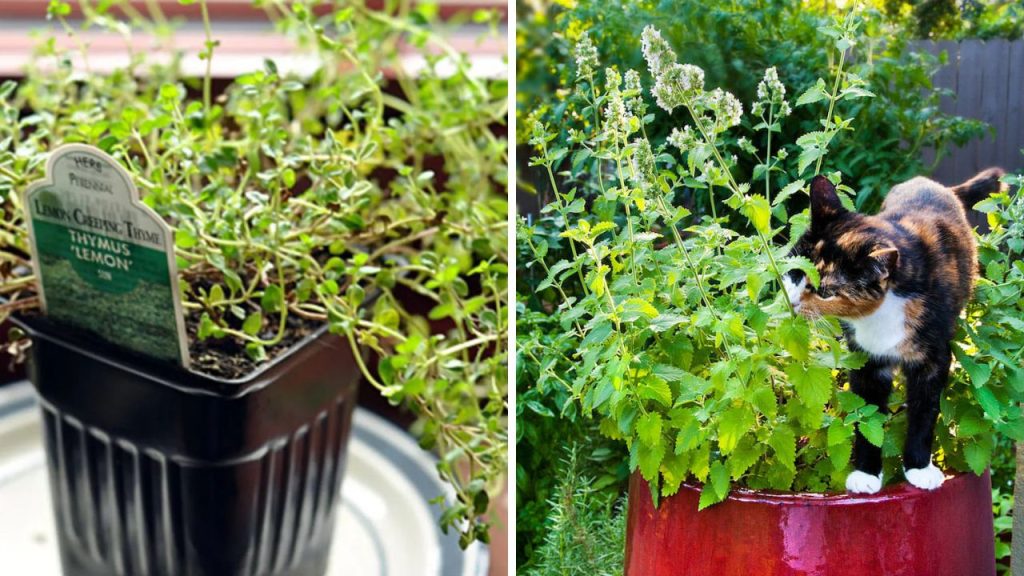Garden pathways are not only practical elements that help you navigate your outdoor space but also serve as an essential part of your landscape design. A well-designed pathway can guide guests through your garden, create a sense of flow, and add aesthetic charm to your backyard. Whether you are looking to create a serene, natural atmosphere or a bold, modern look, there are plenty of options to suit every style and preference. In this guide, we’ve compiled 15 garden pathway ideas to inspire your next outdoor project.
## 1. Gravel Garden Pathway

**Source**
A gravel pathway is one of the most popular and cost-effective options for garden paths. It is highly versatile and can be adapted to fit a variety of garden styles, from rustic to modern. The loose nature of the gravel allows for excellent drainage, making it perfect for areas prone to water accumulation. Gravel paths can be lined with bricks, stones, or even timber to keep the gravel contained and to enhance their visual appeal.
A major advantage of gravel paths is their ease of installation. You can create a DIY gravel pathway by simply clearing the area, laying a weed barrier fabric, and then adding the gravel. The variety of colors and textures available means you can customize your gravel path to suit your existing garden decor. You could even consider adding stepping stones or small pavers to give the pathway a more formal look.
Gravel paths are also incredibly low-maintenance. As long as the gravel is properly laid, it can last for many years. Regular raking and topping up of the gravel will keep the pathway looking neat and functional.
## 2. Flagstone Pathway

**Source**
If you are seeking a timeless and elegant pathway that exudes rustic charm, a flagstone pathway could be the perfect choice. Flagstones are flat, natural stones that are available in various sizes and shapes, allowing you to create an irregular yet visually appealing pathway. This type of path can blend seamlessly with your garden’s landscape, enhancing the natural beauty of your outdoor space.
The key to creating a stunning flagstone pathway is to allow some space between the stones. This gives the pathway a more organic look and allows plants like moss, thyme, or creeping groundcovers to grow between the stones, adding texture and color. Flagstone paths are also incredibly durable and resistant to the elements, making them ideal for year-round use.
A flagstone pathway works well in both formal and informal garden settings. For a more modern take, you can use evenly spaced, large flagstones, while for a more traditional look, opt for smaller, irregularly shaped pieces.
## 3. Wooden Plank Pathway

**Source**
For a rustic, earthy feel, consider using wooden planks to create a garden pathway. Wooden paths can help establish a natural, organic vibe in your garden, blending well with lush greenery and blooming flowers. Depending on the type of wood you choose, a wooden plank pathway can suit a variety of styles, from farmhouse chic to more contemporary outdoor spaces.
Pressure-treated lumber or reclaimed wood can be used for the planks, giving the pathway durability and character. Wooden planks work particularly well in gardens with a forest-like atmosphere or those that feature lots of natural stone and wood elements. You can create a simple, linear path with the planks laid side by side or get creative with a winding, meandering layout for a more whimsical touch.
To ensure longevity, it’s essential to regularly treat the wood to prevent rot and decay, especially in areas with high moisture.
## 4. Cobblestone Pathway

**Source**
A cobblestone pathway brings an old-world charm and elegance to your garden, evoking the feeling of a European countryside. The distinct, textured surface of cobblestones creates a visually stunning and durable path. While cobblestones tend to be more expensive than other options, they provide exceptional durability and long-term value.
Cobblestone paths work beautifully in traditional or Mediterranean-style gardens, adding sophistication to your outdoor space. The stones are available in a range of colors, shapes, and sizes, which allows you to customize the look and feel of your path. Whether you choose a classic herringbone pattern or a more random arrangement, cobblestones make for a striking addition to any garden.
Due to their dense, interlocking nature, cobblestone paths are highly resistant to wear and tear, making them ideal for high-traffic areas. However, they can be challenging to install, so hiring a professional may be necessary if you’re not experienced with DIY stonework.
## 5. Mulch Pathway
**Source**
For a more affordable and eco-friendly garden pathway, a mulch pathway is an excellent choice. Mulch paths are perfect for creating natural, woodland-inspired walkways that blend seamlessly into the surrounding landscape. Mulch can be made from various materials such as wood chips, bark, or pine needles, allowing you to choose the one that best complements your garden.
One of the major benefits of mulch pathways is their softness underfoot, making them ideal for walking barefoot. Additionally, mulch is a great option for weed suppression, as it helps keep unwanted plants from growing along your path. The decomposing mulch also adds nutrients to the soil, benefiting the surrounding plants.
While mulch paths are relatively low-maintenance, they do need to be replenished every year to maintain their appearance and effectiveness. It’s also essential to ensure proper drainage beneath the mulch to prevent waterlogging.
## 6. Brick Pathway
**Source**
Brick pathways are classic and durable, offering a traditional and timeless aesthetic for your garden. They come in a variety of colors and shapes, including rectangular, square, and circular, and can be arranged in many different patterns, such as herringbone, basketweave, or running bond. The versatility of brick allows it to blend effortlessly with various garden styles, from cottage gardens to more modern outdoor spaces.
Installing a brick pathway involves creating a stable foundation, which can include sand or gravel, and carefully laying the bricks to create a flat, even surface. The slight slope of the bricks helps ensure proper drainage, preventing water from pooling in your path.
Brick is also incredibly long-lasting and can withstand heavy foot traffic. Over time, bricks may develop a beautiful patina that adds to the charm of your pathway. A brick path requires little maintenance, aside from occasional cleaning to remove moss or dirt.
## 7. Stepping Stone Pathway
**Source**
A stepping stone pathway is one of the simplest and most stylish ways to create a functional and beautiful garden path. Stepping stones can be made from a variety of materials, including stone, concrete, or even wood. These stones are spaced out at regular intervals, allowing you to walk across your garden while keeping your feet dry and clean.
The beauty of a stepping stone pathway lies in its flexibility. You can place the stones in a straight line, or you can arrange them in a winding pattern for a more natural, meandering look. You can even add small gaps between the stones and fill them with gravel or groundcover plants, such as thyme, to create a more organic appearance.
Stepping stone pathways are particularly ideal for gardens that feature a lot of plants or other landscaping elements, as they allow you to enjoy the beauty of your garden without disturbing the existing plants. The stones are easy to install and can be arranged in a way that suits your space perfectly.
## 8. Concrete Pathway
**Source**
Concrete is an incredibly versatile material, making it a great option for modern and contemporary garden pathways. Concrete pathways are durable, low-maintenance, and can be poured into any shape or size. Whether you choose to use pre-cast concrete pavers or pour the concrete directly into a mold, the result is a sleek, polished path that complements any outdoor living space.
Concrete pathways can be customized with various finishing techniques, such as stamping or staining, to create unique textures and colors. For instance, you can create a stone-like effect or choose bold colors that stand out against the surrounding greenery.
Concrete is also highly durable and can withstand heavy foot traffic, making it an excellent option for busy outdoor areas. Additionally, it is a great material for high-traffic pathways, as it resists erosion and weathering. However, it can be cold and hard underfoot, so it’s ideal for areas where you won’t be walking barefoot frequently.
## 9. Pea Gravel Pathway
**Source**
Pea gravel is an excellent option for creating a pathway that feels both natural and inviting. Its smooth, rounded stones come in a variety of colors, ranging from soft grays to warm tans, allowing you to choose a hue that complements your garden’s aesthetic. Pea gravel paths are perfect for achieving a rustic, casual look while still maintaining a clean, organized appearance.
This type of pathway is easy to install and is highly customizable. You can create a winding, meandering path that follows the natural contours of your garden, or opt for a more structured, straight layout. To keep the gravel contained and prevent it from spilling over, consider adding a border made of stone, metal, or wood. Additionally, using a weed barrier fabric underneath the gravel helps to reduce weed growth, making maintenance minimal.
Pea gravel is not only visually appealing but also functional. The loose nature of the stones allows for good drainage, which prevents water pooling and helps the path stay dry after rain. The sound of the gravel underfoot can also add a soothing element to your outdoor space.
## 10. Mosaic Pathway
**Source**
For a bold and artistic touch, a mosaic pathway can serve as a statement piece in your garden. Using small, colorful stones, tiles, or glass pieces, you can create intricate patterns and designs that reflect your personal style. Whether you want a geometric design, floral motifs, or a more abstract concept, a mosaic pathway allows for endless creativity.
Mosaic paths can be made from a variety of materials, including ceramic tiles, pebbles, or even broken glass. The materials are carefully arranged in a pattern and then set in place with mortar or grout, ensuring that the design is stable and durable. This type of pathway can bring a pop of color and texture to your garden, turning an ordinary path into a captivating focal point.
While mosaic pathways require more effort to install compared to simpler options, the results are well worth it. These paths are especially fitting in artistic or eclectic gardens, as they add a unique, personal flair to your outdoor space.
## 11. Turf Pathway
**Source**
If you love the idea of a lush, green pathway that seamlessly blends into your garden, a turf pathway is an excellent choice. This option is ideal for homeowners looking to maintain a natural, grassy look in their garden without the hassle of constantly mowing a large lawn. Turf paths are easy to install, and the grass grows in a way that keeps the path looking neat and tidy.
Turf pathways can be created by using grass sod or artificial turf to form a continuous line. The beauty of this pathway lies in its ability to blend with the surrounding environment, making it perfect for gardens where you want the path to appear almost invisible. The grass provides a soft, pleasant surface to walk on and works well in eco-friendly or sustainable garden designs.
To ensure your turf pathway stays healthy and lush, it’s essential to choose grass varieties that are well-suited to your climate. Regular watering and occasional maintenance will keep the grass looking its best.
## 12. River Rock Pathway
**Source**
A river rock pathway is another natural option that offers both beauty and practicality. These smooth, rounded stones mimic the appearance of a stream bed, creating a serene and peaceful atmosphere in your garden. River rocks come in a variety of sizes and colors, which means you can choose the perfect combination to suit your landscape.
The beauty of a river rock pathway lies in its rustic charm and organic appeal. When installed correctly, it allows for excellent drainage, which helps prevent water from pooling on the path during heavy rains. River rock paths can be laid in a uniform pattern or in a more random design, depending on your desired look. You can even incorporate larger boulders or small pebbles for added texture and interest.
This type of pathway works well in natural or woodland-themed gardens, as it enhances the earthy, organic vibe. While it can be a bit more labor-intensive to install, the result is a low-maintenance, highly durable path that will last for years.
## 13. Brick Herringbone Pathway
**Source**
A brick herringbone pathway is a sophisticated option that adds a touch of elegance to any garden. The herringbone pattern, with its distinctive V-shaped arrangement of bricks, creates a dynamic and visually interesting design that draws attention. The angular layout of the bricks offers both strength and style, making it an ideal choice for both formal and informal gardens.
To create this pathway, you will need to carefully lay the bricks in a herringbone pattern, ensuring each brick is placed at a 45-degree angle to the next. This method provides a sturdy, stable surface that is durable enough to handle foot traffic for years. A brick herringbone pathway can be installed using mortar or dry-laid for a more casual, relaxed look.
This pathway is a great way to add texture, pattern, and structure to your garden. The herringbone design works especially well in modern, classic, or Mediterranean-inspired gardens.
## 14. Concrete Paver Pathway
**Source**
Concrete pavers are a fantastic way to achieve a clean, modern look in your garden. These pavers are available in a variety of shapes, sizes, and colors, giving you endless possibilities for customization. Whether you prefer a sleek, contemporary design or a more traditional pattern, concrete pavers can help you create a path that suits your personal style.
Concrete paver pathways are incredibly versatile. You can choose from various textures and finishes, such as smooth, rough, or even stamped patterns, to create a pathway that complements your landscape. These pavers are easy to install, as they interlock to form a stable and durable surface that can withstand high foot traffic.
In addition to their aesthetic appeal, concrete pavers are durable and low-maintenance, requiring little more than occasional cleaning to keep them looking fresh.
## 15. Sandstone Pathway
**Source**
If you’re looking for a pathway that combines natural beauty with rustic charm, a sandstone pathway could be the ideal choice. Sandstone, with its rich colors and natural texture, creates a stunning, organic look in any garden. This stone is known for its warmth and versatility, making it perfect for a wide variety of garden designs.
Sandstone is a great option for creating a more traditional, earthy path. The stone can be arranged in various shapes and patterns, from irregular slabs to perfectly cut rectangular pieces. The warm hues of sandstone also blend well with other natural materials, such as wood and plants, making it an excellent choice for creating a cohesive garden aesthetic.
While sandstone is relatively easy to work with, it’s essential to ensure proper drainage beneath the stones to prevent them from shifting or cracking over time. With proper care, a sandstone pathway can last for many years, providing beauty and functionality to your garden.
## Conclusion
Creating a beautiful and functional garden pathway is one of the best ways to enhance your outdoor living space. Whether you prefer a rustic, natural look or a sleek, modern design, there are endless possibilities to suit your style. From classic gravel paths to artistic mosaic designs, each of these 15 garden pathway ideas brings its own unique charm to your garden.
Remember to consider the climate, maintenance needs, and aesthetic of your garden when choosing the right pathway. A well-designed pathway not only guides visitors through your space but also adds a touch of personality and charm to your outdoor environment.
By selecting the perfect pathway idea for your garden, you can transform your outdoor space into a welcoming and beautiful retreat that you’ll enjoy for years to come.

